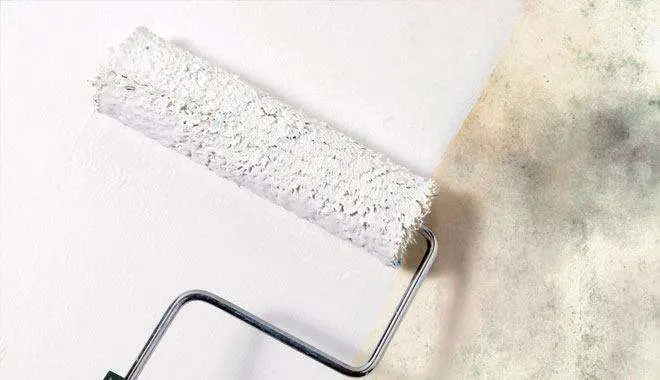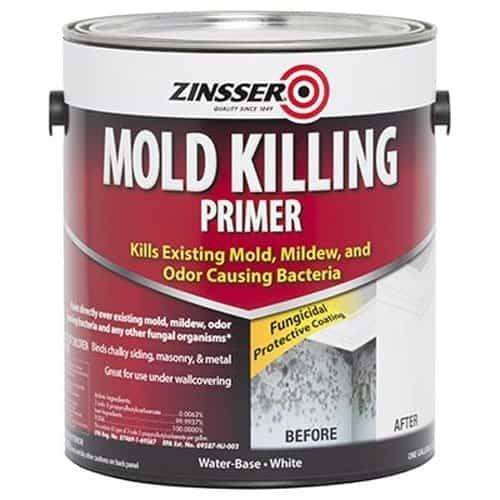Can you paint over mold? Is that a viable way to kill a mold infestation or will it only make things worse? Are there different types of mold paint and different painting techniques that are more or less effective against mold?
These are just a few of the questions that you often hear in relation to mold. If we were psychologists, we could extrapolate an innate human desire to cover up our problems rather than deal with them. Alas, we are just mold specialists, so let’s just tackle the question head-on:
Is painting over mold to kill it a viable strategy?
Yes (but only in the right circumstances).

Painting over mold will only work on a permanent basis if you fix the source of the mold problem first. In addition, you need to purchase a mold killing paint rather than the resistant variety as this is the only way to deal with already existing mold. A mold inhibitor paint helps in preventing the future development of mold, but it isn't the best option to completely eliminate mold.
Which isn’t to say that you shouldn’t consider mold inhibitor paint – if your home or room is prone to developing mold then this is exactly the paint you should look for. There are a lot of great kinds of mold inhibitor paint on the market, so go over them carefully. Before applying the paint itself, however, take care of the mold with other means.
Mold Is Not Dirt Or A Stain
This is something else that a lot of people forget. Mold is an actual microorganism that grows on your walls and other surfaces. It is a fungus and it doesn’t really mind paint. In fact, mold eats through painted surfaces without a problem. That’s why mold causes discoloration – it’s the result of the chemical reactions between the mold and the painted surface.
So, What To Do?
Well, there are a lot of ways to get rid of mold, painting over it is simply one of the most effective options.
So, just identify the type of mold you are dealing with and clean it as well as you can. Mold can be one of many different types. Black mold (Stachybotrys chartarum and chlorohalonata) is generally the most dangerous one and if inhaled it can cause a lot of different health problems – bloating, abdominal pain, headaches, fatigue, weakness, poor memory, shortness of breath, severe allergic reactions, and in extreme situations it can even be deadly. Of course, there are a lot of other types of mold. Generally, they are identified by their color – mold can range from white, through green, gray and brown, to black. Sometimes it’s easily treatable with vinegar, other times it’s near impossible to get rid of even with the strongest industrial cleaners.
There are as many different kinds of mold removers as there is mold. Some are based on bleach formulas, others on ammonia formulas, others on mold-eating enzymes, and so on. Here we are always trying to give you the most detailed reviews and comparisons on all kinds of different products, so take a look around the site if you are looking for a suitable commercial mold remover. A lot of people tend to go with vinegar and we won’t dissuade you from that – vinegar does work. It is a natural, chemical-free and often effective against most types of mold. Keep in mind, however, that vinegar doesn’t work against all kinds of mold and that even when it does it leaves a really heavy smell that’s very hard to get rid of.
Still, it is better than ammonia-based cleaners – ammonia not only doesn’t work that often against mold, but actually offers a beneficial environment for the spreading of some types of mold. So with it you often risk making the problem worse than it already is.
Bleach-based solutions work more often but not always either. Sometimes all bleach does is stain the mold and the surface and leave the mold to keep developing underneath it. Don’t let this discourage you, mold is, for the most part, manageable. Sometimes it’s just harder than expected. Identifying the kind of mold you are dealing with is usually the key point to success that most people miss. This is also one of the several reasons why professional help is often hugely beneficial.
A lot of people try sanding over an infested surface in an attempt to clean it. We’re not exactly certain why people keep doing this but it is far from the smartest thing you can try doing yourself. When you are sanding an infested wall little mold particles start flying all around the air and that’s pretty much the worst thing you want to happen to you. The use of dust mask should go without saying, but we’ll say it nevertheless – inhaling mold particles is not only disgusting but can also be very dangerous and potentially deadly.
If your mold infestation is bad enough for sanding, we’ll again strongly advise you to call a professional.

After you have done all you can about the mold, if some small patches still remain and can’t be cleaned off, consider using a mold sealant before painting over the surface. This process is widely known as encapsulation and acts to seal any remaining mold that can’t be otherwise removed. This is an acceptable way to prevent mold from spreading under the paint when all fails, as long as the remaining mold is truly small and insignificant enough. The mold sealant also helps with future prevention of mold growth and spreading. Also, remember to wait for the mold sealant to dry off completely before painting over it. Dry conditions are essential to battling mold.
Remember – the mold sealant is only a last resort and only for the smallest patches of remaining mold. Mold sealant is far from a guarantee against mold – if you are able to deal with the mold completely you absolutely should since an overly stubborn mold can keep spreading even after the mold sealant and paint has been applied. This isn’t to say that mold sealants don’t work, they do. However, mold is just that tenacious and can sometimes spread through the surface below it and the sealant.

If Not To Kill Mold, When Should I Use Mold Resistant Paint?
Mold resistant paint is designed to work in rooms with extra moisture in the air. The kitchen, the bathroom, moist closets, the basement, the attic, and all rooms that have had mold problems before. As we said, the fact that mold resistant paint doesn’t kill the mold, doesn’t mean that it doesn’t work – killing mold is just not what it is made for. You can good mold resistant paints from any reputable home improvement store. These paints may not be a guarantee that mold won’t spread in the future, but they certainly help a lot.
Before painting over the surface with a mold resistant paint, make sure that the surface is as clean as possible, that all the mold is either removed or covered with a mold sealant, and that the surface is as dry as possible. One of the few things that are worse than painting over mold is painting over wet mold.

Keeping Further Mold Outbreaks At Bay
Once the paint is applied to the wall and is properly dried off there isn’t much more you are supposed to do. However, if preventing the future development of mold is a concern, then there are a lot of different actions you can and should consider.
Generally speaking, you need to make sure that the conditions in the room are as unfriendly towards mold as possible. They need to be dry and properly ventilated and you need to remove any form of condensation. If the room is used regularly, then keeping a warm and dry temperature is a good thing to do against the future development of mold, but there are situations when even that isn’t enough.
If the mold is extra stubborn and / or the wall it is spreading on is just too susceptive to mold, you might need the extra help of a dehumidifier. Some walls and buildings just can’t not develop mold because of their structure and the outside weather. A good dehumidifier can help immensely in situations such as these. A lot of people get put off by the idea of a dehumidifier because they imagine a huge, industrial grade, whole home machine that connects to the HVAC. And while there are, of course, such dehumidifiers, if the problem is localized in one room or your place isn’t that big, a small portable dehumidifier can work wonders as well.
Aside from that, you should just keep the levels of moisture and humidity in the room within an acceptable region and routinely check for even the smallest signs of a new mold infestation.

